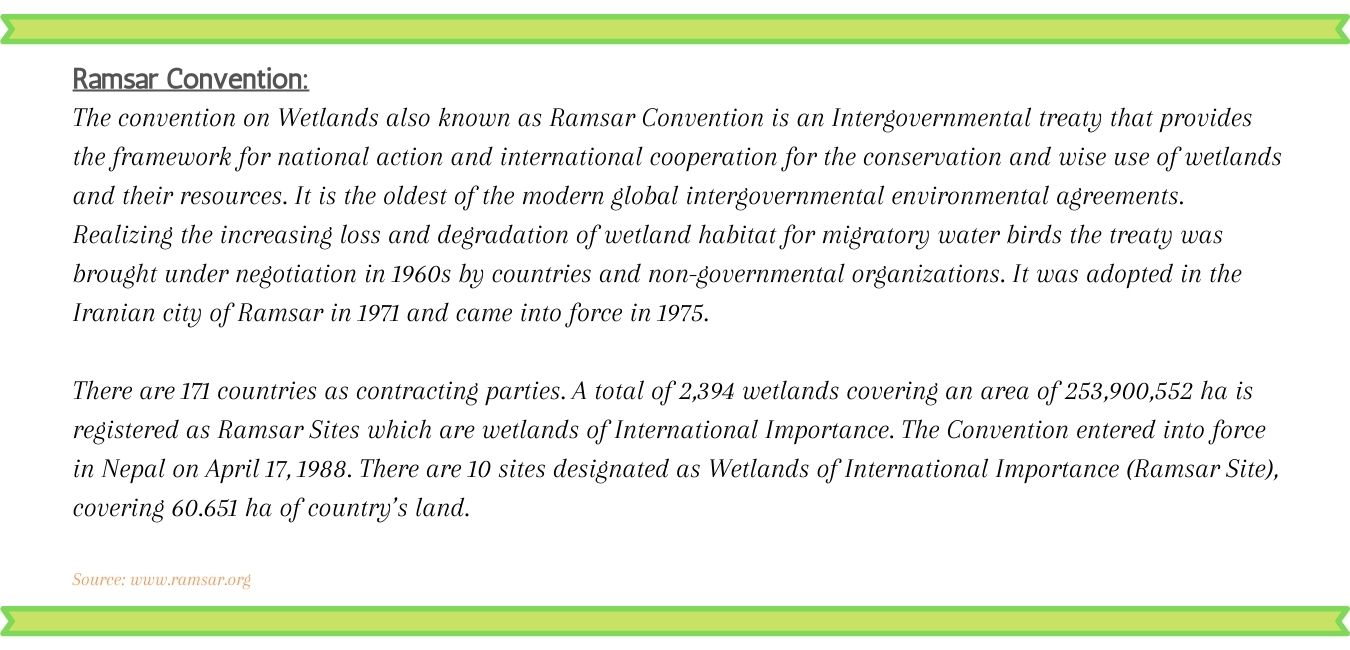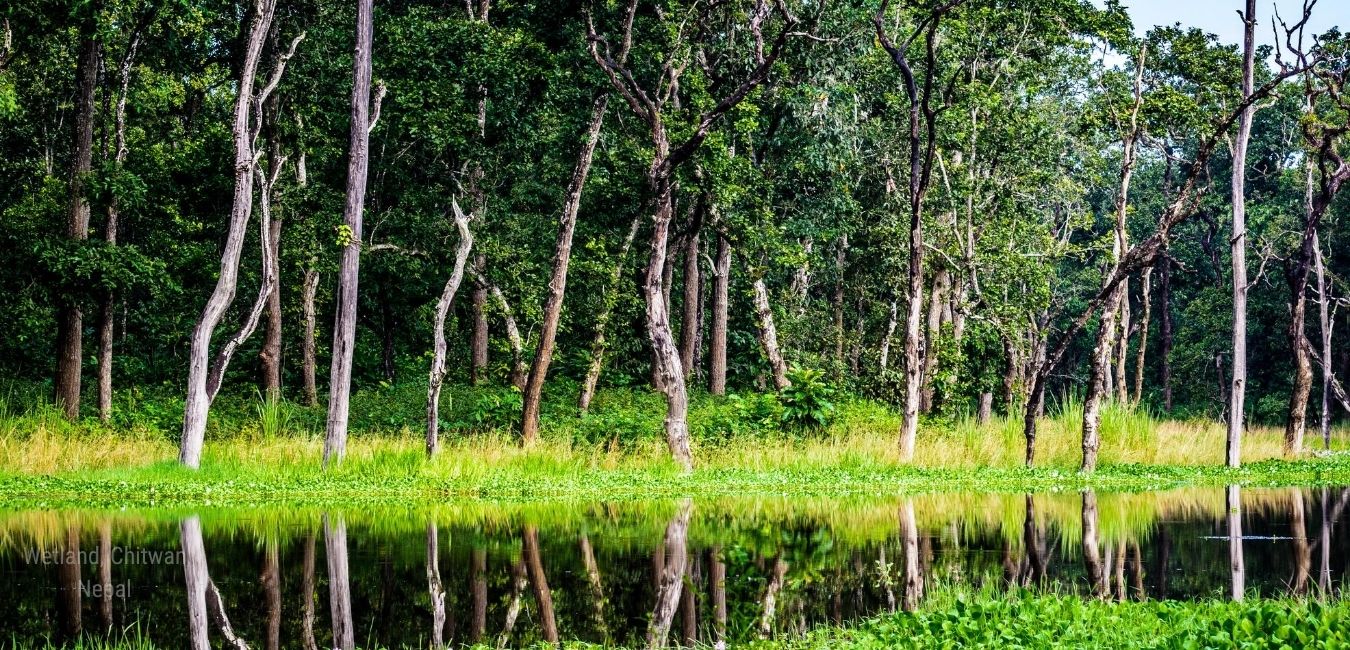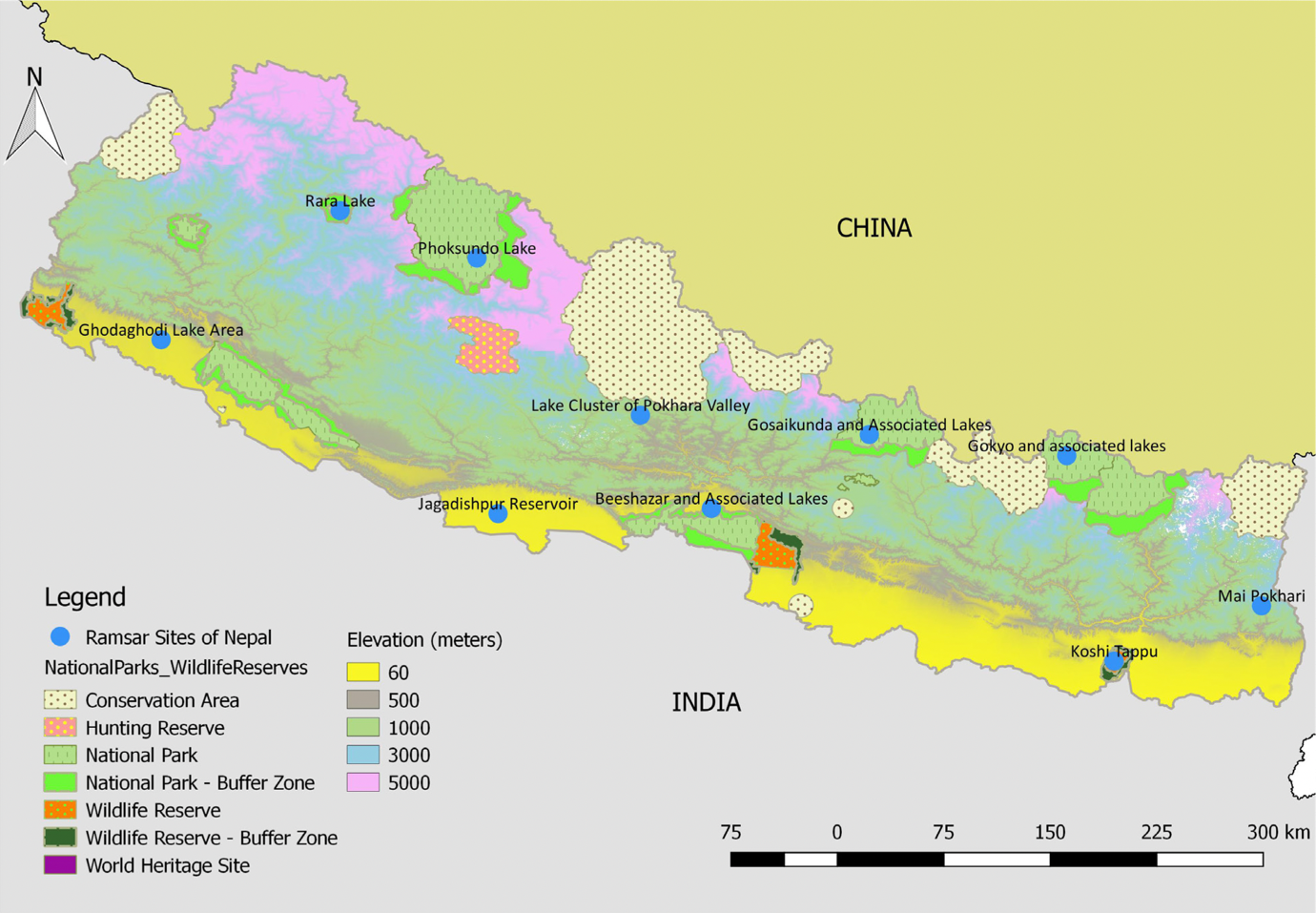Wetlands are home to diverse flora and fauna around the world. The Convention on Wetlands also known as Ramsar Convention defines Wetlands as “Areas of marsh, fen, peat land or water, natural or artificial, permanent or temporary where the water is static or flowing, fresh, briny or salty, including areas of water logging made by man like paddy fields, the depth of which at low tides does not exceed 6 meters.” Around 5 % of land in Nepal is occupied by wetlands. The wetlands of Nepal, from glacial lakes to reservoirs to paddy fields, are distributed across the country from low lying flat Terai to Himalayas. The National Wetland Policy (NWP) 2012 of Nepal defines wetlands as “perennial water bodies that originate from underground sources of water or rainfall. It means swampy areas with flowing or stagnant fresh or salt water that is natural or man -made, or permanent or temporary. Wetlands also mean marshy lands, riverine floodplains, lakes, ponds, water storage areas and agricultural lands.” Wetlands of Nepal is categorized as Rivers, Lakes, Reservoirs, marshy Lands, Ponds and Irrigated paddy fields covering an estimated area of 819277 ha. There are 19 types of natural and 10 types of man-made inland wetlands in Nepal. Nepal has 10 wetlands listed as Ramsar sites and have international recognition.
Wetlands hold ecological, cultural and economic values and are significant for the wellbeing of the natural ecosystem and communities. Most of the rural communities of Nepal are dependent on wetland resources for their livelihood. For marginalized and indigenous communities such as
Majhi Jalari, Tharu and Mallah wetlands are important income generating resource.
Many threatened and endangered species are found in the wetlands of Nepal. It is an important ecological habitat for migratory birds, aquatic animals and other wild species. It provides shelter to 230 indigenous fish species (Rajbanshi, 2013), 102 species of phytoplankton, 109 species of mollusks, 117 species of amphibians (IUCN, 2004; ICIMOD and MoEST, 2007; Budha 2012, NBSAP, 2014). Likewise, its home to 27 % of nationally threatened bird species (BCN and DNPWC, 2010), 85 % of endemic vertebrates (IUCN, 2004), and 24 % of Nationally protected plants.
Wetland serve a wide variety of ecosystem services: regulation of water, water supply, erosion control, waste treatment, atmospheric and climate regulation, biological control, provides a suitable habitat, raw material, genetic resources and food production. It also has an important cultural and recreation values and supports in soil formation, nutrient cycling and pollination.
But wetlands of Nepal are fast disappearing. Urban and economic development has resulted into its degradation. Around 5.41 % of the total wetland area has been converted into croplands. Unclear policies and management responsibilities, lack of technical, financial and institutional capacities have added to the degradation of wetlands. In addition to this encroachment, invasion of alien species, siltation, unsustainable use of wetland resources has resulted into further degradation of this diverse ecosystem.
It is essential to build the capacity of the wetland communities along with the general public on the conservation and protection of wetlands. WCN since its establishment focusses on the conservation of wetlands across the country through education and community participation. WCN has developed education materials for students and teachers in order to familiarize them with the importance of wetlands, document local wetland areas of importance and work towards conserving them. In an attempt to support the National Ramsar Strategy and Action Plan, 2018 – 2024, WCN is also working towards engaging local and federal stakeholders to build knowledge on wetlands and develop innovative solutions for wise use of wetlands while conserving it.
 References:Budha, P. B. (2012). Review of freshwater and terrestrial Molluscan studies in Nepal: Existing problems and future research priorities. Presented at the Entomological Review Workshop organized by Nepal Agriculture Research Council, Khumaltar during 4-6 March 2012.
References:Budha, P. B. (2012). Review of freshwater and terrestrial Molluscan studies in Nepal: Existing problems and future research priorities. Presented at the Entomological Review Workshop organized by Nepal Agriculture Research Council, Khumaltar during 4-6 March 2012.
Conservation and Sustainable Use of Wetlands in Nepal. (2010). Wetland-Resource Book. Conservation and Sustainable Use of Wetlands in Nepal. Kathmandu, Nepal: Ministry of Forest and Soil Conservation.
Government of Nepal/Ministry of Forests and Soil Conservation. Wetland Policy 2069 (2012).
International Union for Conservation of Nature Nepal (Ed.). (2004). A review of the status and threats to wetlands in Nepal. Kathmandu: IUCN Nepal.
Inskipp, C., Baral, H. S., Inskipp, T., andStattersfield, A. (2013). The state of Nepal birds 2010. Journal of Threatened Taxa, 5(1), 3473–3503.
His Majesty’s Government of Nepal/Ministry of Forest and Soil Conservation. (2002). National Biodiversity Strategy. Kathmandu, Nepal: His Majesty’s Government of Nepal/ Ministry of Forest and Soil Conservation.
Ministry of Forests and Environment 2018. National Ramsar Strategy and Action Plan, Nepal (2018-2024). Ministry of Forests and Environment, Singha Durbar, Kathmandu, Nepal
www.ramsar.org 

 Wetlands are home to diverse flora and fauna around the world. The Convention on Wetlands also known as Ramsar Convention defines Wetlands as “Areas of marsh, fen, peat land or water, natural or artificial, permanent or temporary where the water is static or flowing, fresh, briny or salty, including areas of water logging made by man like paddy fields, the depth of which at low tides does not exceed 6 meters.” Around 5 % of land in Nepal is occupied by wetlands. The wetlands of Nepal, from glacial lakes to reservoirs to paddy fields, are distributed across the country from low lying flat Terai to Himalayas. The National Wetland Policy (NWP) 2012 of Nepal defines wetlands as “perennial water bodies that originate from underground sources of water or rainfall. It means swampy areas with flowing or stagnant fresh or salt water that is natural or man -made, or permanent or temporary. Wetlands also mean marshy lands, riverine floodplains, lakes, ponds, water storage areas and agricultural lands.” Wetlands of Nepal is categorized as Rivers, Lakes, Reservoirs, marshy Lands, Ponds and Irrigated paddy fields covering an estimated area of 819277 ha. There are 19 types of natural and 10 types of man-made inland wetlands in Nepal. Nepal has 10 wetlands listed as Ramsar sites and have international recognition.
Wetlands are home to diverse flora and fauna around the world. The Convention on Wetlands also known as Ramsar Convention defines Wetlands as “Areas of marsh, fen, peat land or water, natural or artificial, permanent or temporary where the water is static or flowing, fresh, briny or salty, including areas of water logging made by man like paddy fields, the depth of which at low tides does not exceed 6 meters.” Around 5 % of land in Nepal is occupied by wetlands. The wetlands of Nepal, from glacial lakes to reservoirs to paddy fields, are distributed across the country from low lying flat Terai to Himalayas. The National Wetland Policy (NWP) 2012 of Nepal defines wetlands as “perennial water bodies that originate from underground sources of water or rainfall. It means swampy areas with flowing or stagnant fresh or salt water that is natural or man -made, or permanent or temporary. Wetlands also mean marshy lands, riverine floodplains, lakes, ponds, water storage areas and agricultural lands.” Wetlands of Nepal is categorized as Rivers, Lakes, Reservoirs, marshy Lands, Ponds and Irrigated paddy fields covering an estimated area of 819277 ha. There are 19 types of natural and 10 types of man-made inland wetlands in Nepal. Nepal has 10 wetlands listed as Ramsar sites and have international recognition. Ten Ramsar Sites of Nepal (Source: Nepal Ramsar Strategy and Action Plan, 2018-2024)
Ten Ramsar Sites of Nepal (Source: Nepal Ramsar Strategy and Action Plan, 2018-2024)